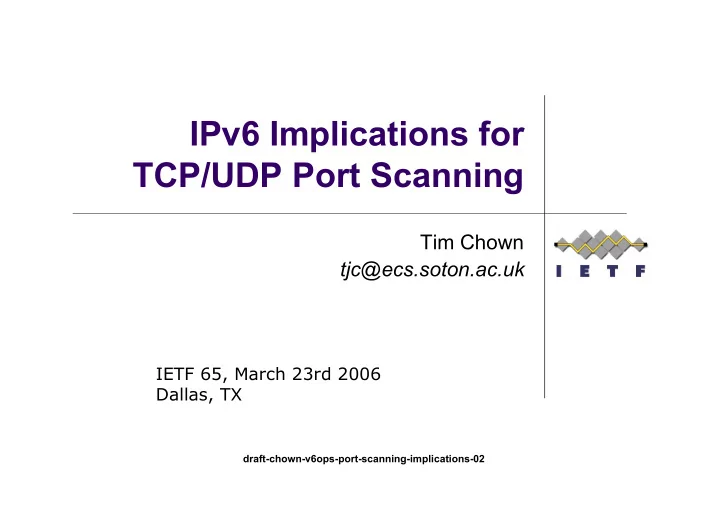

IPv6 Implications for TCP/UDP Port Scanning Tim Chown tjc@ecs.soton.ac.uk IETF 65, March 23rd 2006 Dallas, TX draft-chown-v6ops-port-scanning-implications-02
Rationale The goals of the document are currently to Note the properties of the vastly increased host address space in an IPv6 subnet (/64) or site (/48) With respect to traditional port scanning probes Describe new methods that attackers may use to identify target nodes Given the target host address space is so large Make recommendations to administrators to mitigate against new attack vectors Publish document as Informational in the first instance draft-chown-v6ops-port-scanning-implications-02
Traditional port scanning To scan one port per node in a /64 IPv6 subnet per second would require 500 billion years Can reduce search space from 64 to 24 bits If SLAAC used, knowing :fffe: padding & vendor codes Not practical; unlikely to be used by attackers Scans also used by worms Active propagation intra- or inter-subnet Address space used much more densely in IPv4 site Need to identify target nodes Used by local admins for ‘defensive’ scanning Market for IPv4 ‘penetration testing’ - what’s IPv6 market? draft-chown-v6ops-port-scanning-implications-02
Recommendations For administrators Consider subnet/host numbering plans Potential for rolling server addresses Consider where addresses/prefixes may be gleaned Passive or active gathering Mail headers, application access logs, etc Possible site-scope multicast operations Use of RFC3041 to reduce useful lifetime of exposed address information to an attacker Contradicts ease of management Considerations for ‘defensive’ scanning draft-chown-v6ops-port-scanning-implications-02
Comments received on -02 Title should be about ‘address’ not ‘port’ scanning Or perhaps ‘host address discovery’ Look at Bellovin paper http://www.cs.columbia.edu/~smb/papers/v6worms.pdf Attackers will find a way; don’t suggest IPv6 offers protection; document new attack vectors and offer recommendations RFC3041 is a good thing Exposed to weakest of protocols in dual-stack network draft-chown-v6ops-port-scanning-implications-02
Next steps? Various edits Need to expand Section 3 on attack vectors Add conclusions Is direction of document useful? WG adoption? Referenced in two mature v6ops drafts NAP and ICMP filtering Comments? draft-chown-v6ops-port-scanning-implications-02
Recommend
More recommend